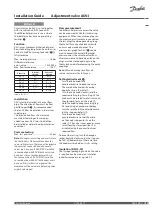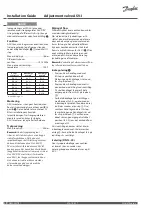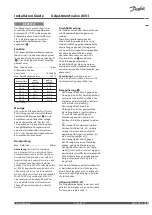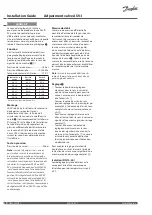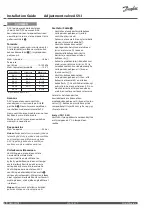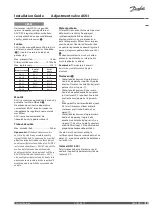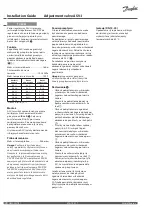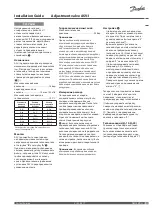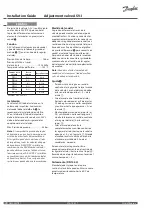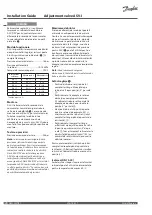
33
Adjustment valve ASV-I is used together
with riser valve ASV-P/PV to control
the differential pressure in risers where
the radiator valves have no presetting
facilities
➊
.
Function
ASV-I gives maximum limitation of water
flow (see Setting/adjustment) and the riser
can be shut off by turning the knob (
❷①
)
fully clockwise.
Max. working pressure .......................... 16 bar
Differential pressure
across valve ...................................... 10-150 kPa
Max. flow temperature .......................... 120 °C
Valve size
Internal
thread
External
thread
DN 15
R
p
½
G ¾ A
DN 20
R
p
¾
G 1 A
DN 25
R
p
1
G 1¼ A
DN 32
R
p
1¼
G 1½ A
DN 40
R
p
1½
G 1¾ A
DN 50
-
G 2¼ A
Impulse line: G 1⁄16
Installation
ASV-I must be installed in the riser flow
pipe. The direction of flow must be from
port
B
to port
A
❸
. It is recommended
that an FV filter be installed in the system
supply pipe.
The impulse line from the riser valve
must be fitted using an 8 mm open-
ended spanner. ASV-I must in addition
be installed as determined by installation
conditions.
Pressure testing
Max. test pressure ................................... 25 bar
Note:
When pressure testing you must secure
that both sides of the membrane have the
same static pressure. That means the impulse
tube must be connected and any needle
valves must be open. If ASV-P/PV is installed
in combination with ASV-M both valves can
be open or closed (both valves must be in
the same position!). If ASV-P/PV is installed
in combination with ASV-I both valves must
be open. If this instruction is ignored, the
membrane of the automatic balancing valve
might be damaged.
Flow measurement
The differential pressure across the valve
can be measured by Danfoss measuring
equipment. When the quick couplings on
the measuring instrument are connected,
the test plugss can be opened by giving
them a half-turn counterclockwise with
an 8 mm open-ended spanner. The
pressure loss graph for ASV-I
❹
can be
used to convert the actual differential
pressure across the valve to actual flow.
After measurements have been taken, the
plugs must be closed again by turning
them clockwise before removing the quick
couplings.
Note:
When measuring sized flow, all
radiator valves must be fully open.
Setting/adjustment
❺
• Turn the valve knob fully
counterclockwise to open the valve.
The mark on the knob will now be
opposite »0« on the scale
①
.
• Turn the valve knob clockwise to the
required setting (e.g. for setting 2,2 the
knob must be rotated two full turns and
then forward to »2« on the scale
②
.
• Hold the knob to keep the setting (e.g.
2,2) and using a hexagon socket key
turn the spindle fully counterclockwise
(until a stop can be felt),
③
.
• Turn the valve knob fully
counterclockwise so that the mark
on the knob is opposite »0« on the
scale
①
. The valve is now open as many
turns from the closed position (2,2)
as indicated by the convertion from
required flow.
To annul the setting, turn the hexagon
socket key fully clockwise (until a stop can
be felt),
④
. Remember, at the same time
the knob must be held on its »0« setting.
Insulation (DN 15-40)
The styropor packaging in which the valve
is supplied can be used as an insulation
jacket for temperatures up to 80 °C.
Installation Guide
Adjustment valve ASV-I
District Energy
VI.A1.K5.1T
DEN-SMT/SI
ENGLISH



